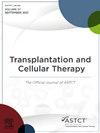Lipid Levels Increase to the Normal Range After Nonmyeloablative Hematopoietic Cell Transplantation for Sickle Cell Disease
IF 3.6
3区 医学
Q2 HEMATOLOGY
引用次数: 0
Abstract
Individuals with sickle cell disease (SCD) have a unique type of dyslipidemia characterized by low total cholesterol (TC), low low-density lipoprotein cholesterol (LDL-c), low high-density lipoprotein cholesterol (HDL-c), and normal triglycerides (TG). This lipid state is theorized to be cardioprotective against atherosclerosis. In SCD, hematopoietic cell transplant (HCT) offers a potentially curative therapy. Long-term survivors of HCT for hematologic malignancies are at increased risk for dyslipidemia and atherosclerosis long-term. The effects of HCT on SCD dyslipidemia are unknown. This retrospective cohort study characterizes lipid profiles at baseline and after nonmyeloablative allogeneic HCT for SCD. We analyzed data from 116 patients after nonmyeloablative HLA-matched sibling or haploidentical HCT for SCD at the NIH from 2009 to 2021. TC, HDL-c, LDL-c, and TG were collected pre-HCT, 1-year post-HCT, and annually thereafter. Data were analyzed using linear generalized estimating equation regression modeling. Successful HCT was associated with a rise in TC, LDL-c, and HDL-c and a decline in TG post-HCT. After HCT, previously low lipid levels increased to the normal range. These changes occurred within the first year of HCT and were maintained thereafter. In patients with graft failure, TC and LDL-c levels remain unchanged from their pre-HCT baseline. Sirolimus use for graft versus host disease prophylaxis was associated with higher TG levels. These findings suggest that SCD dyslipidemia resolves with reversal of the SCD phenotype. The normalization of lipid parameters suggests SCD patients are not at increased risk for atherosclerosis after successful HCT compared to their peers; further studies with longer follow-up are required.
镰状细胞病非消融性造血细胞移植后,血脂水平升至正常范围。
背景:镰状细胞病(SCD)患者有一种独特的血脂异常类型,其特征是低总胆固醇(TC)、低低密度脂蛋白胆固醇(LDL-c)、低高密度脂蛋白胆固醇(HDL-c)和正常甘油三酯(TG)。理论上,这种脂质状态可以防止动脉粥样硬化。在SCD中,造血细胞移植(HCT)提供了一种潜在的治疗方法。血液恶性肿瘤HCT的长期存活者患血脂异常和动脉粥样硬化的风险增加。HCT对SCD血脂异常的影响尚不清楚。目的:这项回顾性队列研究描述了SCD患者非清髓性同种异体HCT治疗前后的脂质谱。研究设计:我们分析了2009年至2021年在NIH接受非清髓性hla匹配的同胞或单倍体相同HCT治疗SCD的116例患者的数据。总胆固醇、HDL-c、LDL-c和TG分别在hct前、hct后一年和之后每年收集。数据分析采用线性广义估计方程回归模型。结果:HCT成功与HCT后TC、LDL-c和HDL-c升高以及TG下降相关。HCT后,先前的低脂水平上升到正常范围。这些变化发生在HCT的第一年,此后一直保持不变。在移植物失败的患者中,TC和LDL-c水平与hct前的基线水平保持不变。西罗莫司用于移植物抗宿主病预防与较高的TG水平相关。结论:这些发现表明SCD血脂异常随着SCD表型的逆转而消退。脂质参数的正常化表明,与同龄人相比,HCT成功后SCD患者发生动脉粥样硬化的风险没有增加;需要更长的随访时间进行进一步的研究。
本文章由计算机程序翻译,如有差异,请以英文原文为准。
求助全文
约1分钟内获得全文
求助全文
来源期刊

Transplantation and Cellular Therapy
Medicine-Hematology
CiteScore
7.00
自引率
15.60%
发文量
1061
审稿时长
51 days
 求助内容:
求助内容: 应助结果提醒方式:
应助结果提醒方式:


